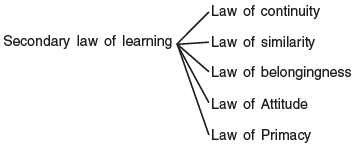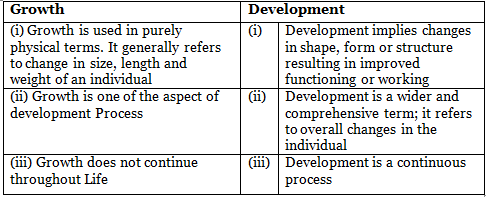Important Questions: Phychology and Sports | Physical Education Class 11 (XI) - CBSE and NCERT Curriculum PDF Download
Very Short Answer Questions
Q1: Give definition of Psychology?
Ans: Psychology is the science of human behavior.
Q2: What do you understand by term Sports Psychology
Ans: Sports psychology is the application of psychological Principles to sports and physical activity at all levels of skill improvement.
Q3: Define the term Growth and development?
Ans: Growth - The term growth in physical education means the growth of the parts of the body, may be in size, height and weight Development can be defined as progressive series of changes in an orderly coherent pattern.
Q4: Define Adolescence?
Ans: Adolescence is the period of great stress and strain, storm and strife
or
Adolescence is the period of change from childhood to adutlthood.
Q5: Which type of physical activities can be played in early childhood?
Ans: The play activities in the age group should not be strenuous because physical capacities develop slowly. The fundamentals of various games and sports which are simple should be introduced.
Q6: Which type of physical activities can be played during adolescence?
Ans: In this age group team sports, individual sports, athletics, gymnastics, swimming and floor dancing etc. can be played.
Q7: What do understand by learning?
Ans: Learning in the broadest sense, is the organisations of behaviour according to the performance demands of some task.
Q8: Mention two laws of learning
Ans:
- Primary laws of learning
- Secondary laws of learning
Q9: Define Transfer of learning?
Ans: Transfer of learning occurs when a person’s learning in one situation influences his learning and performances in other situations.
Q10: What is positive transfer of learning?
Ans: When there is an improvement in a performance as a result of previous learning or training.
Q11: What is negative transfer of learning?
Ans: When learning one skill makes learning of the second skill more difficult.
Q12: Write note on Infancy?
Ans: During this stage of body, the growth and development occur in progressive manner individual gains considerable weight and height . The cognitive development starts.
Q13: Enlist the problems of adolescence.
Ans:
- Aggressive and violent behaviour
- Physical problem
- Lack of concentration
- Attraction towards opposite sex
Short Answer Questions
Q14: Mention the importance of sports psychology
Ans:
- Improve performances - The Knowledge of sports psychology helps to improve performance and personality of players’s by scientific ways of modifying behaviour.
- Motivation and feedback -proper motivation and proper feedback enhances the performance of players. It gives counseling to players. This can be guided by sports psychology.
- Better selection : The knowledge of sports psychology guides the coaches for better selection of players.
Q15: Explain the law of exercise.
Ans: Law of exercise - Repetition of experiences increase the probability of a correct response but it will not enhance learning without satisfying effect following the response. This law is also known as law of use and disuse.
Practice makes the learning bond stronger thus more we practice or use the better is learning.
Q16: Enlist the secondary laws of learning and explain any one law.
Ans: Law of belongingness
Law of belongingness
If the mutual relationship between stimulus and response is natural then learning is more effective for example running, jumping and throwing are natural activities therefore these activities are easy to learn. Along with this, these activities can be learnt quickly. The activities which are artificial or unnatural are difficult to learn such as to run backward while using hands and legs properly is difficult.
Q17: Describe any two developmental characteristics of adolescence
Ans: Physical characteristics
(i) Gain in height, weight and ossification of bones is almost complete
(ii) Endurance is developed to a great extent
(iii) Co-ordination of muscles reaches it peak.
Mental characteristics
People of this age begin to think and feel differentially. Hormonal changes reflect in behaviour and mood. Teenages become sulleing, short tempered, moody and irritable. They also become very self conscious and extra sensitive.
Q18: Highlight the differences between growth and development
Ans:
Q19: Describe the development characteristics during early childhood.
Ans: Physical characteristics
- It is a period of slow but steady growth in height. Bones are soft.
- Weight increase in stready
- Pulse rate is higher than adults
- The heart size is smaller in comparison to the body.
- Strength is not well developed
Mental Characteristics
- Child loves to take part in exercises and activities
- Imitations is a strong Characteristics
- Sex differences have no role in activities.
Q20: Give the ways to overcome Plateau?
Ans:
(i) Develop interest - Develop interest and bring recreation in training .
This gives enjoyment and pleasures to perform activity.
(ii) Reduce competition - Too much competition should be avoided and equal levels should be considered for competition.
(iii) Proper rest and recover - Proper rest and recovery should be taken to overcome plateau. Care should be taken that it should not be too long.
Q21: Explain the concept of emotions.
Ans: Emotions are consistent responses to internal or external events, which have particular significances for organism. These response may be verbal, physiological, behavioural and natural mechanism emotions may be positive or negative like joy versus sadness anger versus fear, trust versus distrust, surprise versus anticipation.
Long Answer Questions
Q22: Explain any four problems of adolescents
Ans:
- Aggressive and Violent Behaviour: Adolescent has aggressive behaviour and often becomes violent very fast. They easily become, irritated and repulsive when work is not of their interest.
- Problems related to physiological growth. The physiological changes associated with adolescence present conditions and problems that the adolescence has not met upto this time and in may cases is ill prepared to meet them when they appear.
- Confusion between adolescent’s role and status unfortunately neither the adolescent’s role nor his status is clear cut in the society. A boy may be treated like a man in many situations outside but like a child in his own home.
- Problems related with the future: The adolescence is a period when the individual is not a child, he has emerged from the safe and protected life of childhood. He has now to decide as120 to what course of life he has to follow.
Q23: Discuss the factors affecting transfer of learning.
Ans: They are some of the factors which affect the transfer of learning they are:
- Learner ’s will - If the learner has strong will, he will be able to transfer his learning more to new situations.
- Learner’s Intelligence - Learner’s Intelligence plays a vital role in the transfer of learning. It has been observed that the students who have more intelligence are for better in transfer of learning in comparison to those who have normal intelligence.
- Depth of original understanding - If a student has enough depth of original understanding of a skill, he becomes more capable of learning new skills.
- Learner ’s Personal Achievement : The learner ’s personal achievement in the field of education have a positive effect on the transfer of learning.
- Training in transfer - If a student has imparted training in transfer he becomes capable of learning new skills very easily. If he is not provided such training it will be very difficult for him to learn the skills.
Q24: What is Plateau? Mention its causes.
Ans: The general trends of rapid beginning continues for some time after it slows down and reaches a level where no further improvement occurs.
The learning curve travels in almost a horizontal plane. These horizontal stretches indicative of no apparent progress are called plateau.
Causes of Plateau
- Boredom - Some routine work often brings boredom, it is one of the cause of boredom
- Lack of Practice - Lack of practice often causes plateau and stagnated performance
- Dirty environment - Poor, dirty and unsafe environment may cause plateau.
- Lack of Motivation - Lack of Motivation and less feedback often causes long learning plateau.
Q25: Define learning and state primary law of learning?
Ans:
(i) Learning may be defined as the process by which behaviour originates or is altered through training or experience .
(ii) It is regarded as modification of both behaviour and the way of perceiving.
Primary laws of learning are as follow
- Law of effect - is a satisfying effect following the response strengthens the connection between stimulus and the behaviour.
- Law of exercise - repetition of experience increases the probability of a correct response but it will not enhance learning without a satisfying effect following the response.
- Law of readiness - The execution of an action in response to a strong impulse is satisfying but the blocking of action or forcing is annoying.
Q26: Explain emotion. How can we control emotion?
Ans:
(i) Emotions are intense feeling that are directed at someone or something. They are subjective, concious experiences characterised by expressions, biological reactions and medical status.
(ii) It is complete physiological state that involve three distinct components
(a) a subjective experience
(b) a physiological response
(c) a behavioural or expressive response
Methods of controlling emotions:
- Stop and evaluate - One of the best thing you can do is mentally stop yourself and look at the situation. Then think the positive aspects of your current situation.
- Physical activity - It changes the mood by taking in distraction, thus perform physical activity.
- Take proper food : Amount of salt may be reduced in food. Quantity of potassium may be controlled which is responsible for systolic and diastolic pressure reduction in blood. We should include pear, tomato, banana, orange and nuts in our food.
- Avoid tension : Tension increases high BP. So we should remain tension free in difficult situations also participation in games and entertainment activities reduce high BP.
- Exercise regularly and participation in games and sports : Regular exercise help in reduction of high blood pressure. Average types of exercise done vigorously for a longer period of time are very effective in reducing high BP. In the beginning exercise may be done at slow pace, then the pace may be increases slowly.
|
33 videos|47 docs|23 tests
|





















